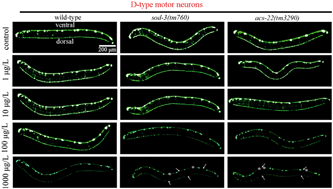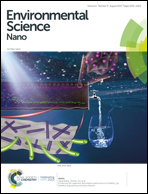Neuronal damage induced by nanopolystyrene particles in nematode Caenorhabditis elegans†
Abstract
The potential adverse effects of nanoplastics have gradually gained significant attention. Herein, we employed Caenorhabditis elegans to investigate the possible neurotoxic effects of nanopolystyrene particles on the development and function of D-type GABAergic motor neurons. Nanopolystyrene (1000 μg L−1) induced the neurodegeneration of D-type motor neurons in wild-type nematodes, and nanopolystyrene (≥100 μg L−1) further induced the neurodegeneration phenotype in nematodes with a mutation in sod-3, encoding a Mn-SOD or acs-22, which governs the functional state of the intestinal barrier. Meanwhile, nanopolystyrene (≥10 μg L−1) decreased head thrash and body bend, and nanopolystyrene (≥100 μg L−1) altered forward and backward movements in wild-type nematodes. Moreover, nanopolystyrene (≥1 μg L−1) decreased head thrash and body bend and nanopolystyrene (≥10 μg L−1) affected forward and backward movements in sod-3 or acs-22 mutant nematodes. Along with the neurotoxicity observed in nanopolystyrene-exposed nematodes, nanopolystyrene exposure induced a dynamic autophagy induction. RNAi knockdown of lgg-1 encoding a key regulator of autophagy induced susceptibility to the neurotoxic effects of nanopolystyrene particles on the development and function of D-type motor neurons, implying the association of dynamic autophagy induction with the neurotoxicity induced by nanopolystyrene particles. Our results highlight the potential neurotoxicity of long-term nanoplastic exposure in organisms.

- This article is part of the themed collection: Best Papers 2019 – Environmental Science: Nano


 Please wait while we load your content...
Please wait while we load your content...